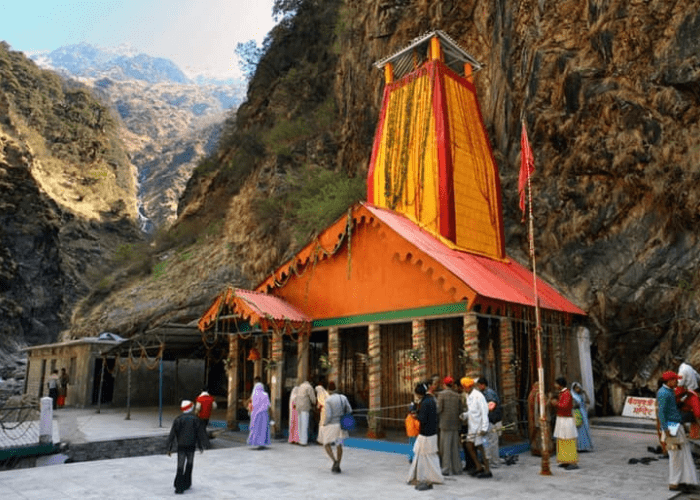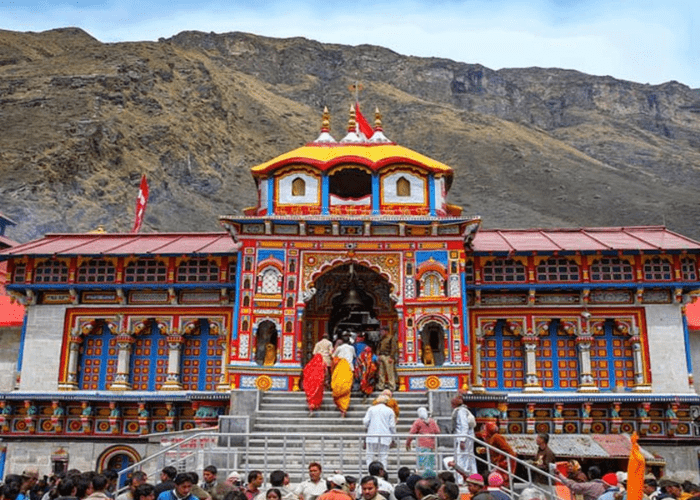
Shri Badrinath Temple
Shri Badrinath, one of the most important and oldest Hindu pilgrimage & one of the integral part of sacred ‘Char Dham Yatra, Located at Garhwal region of Uttarakhand with an altitude of over 3,133 metres at the confluence of the Rishi Ganga and alaknanda Rivers is flanked by nar and Narayan mountains, while the Neelkandth Peak forms a splendid backdrop .
The name of the temple “Badrinath” is associated with the ancient tradition, according to which, Lord Vishnu performed austerity in this place. In order to save her husband from the scorching rays of the sun, the goddess Lakshmi took the form of a tree of Vishala-Badari (Great Fig tree), hiding the god under the shade of the branches. Satisfied with the devotion of a consort, Lord Vishnu said that from now on this place would bear her name.

History of Badrianth Temple
Legends suggest that the original temple was built by King Pururava prior to the vedic age and the idol of the presiding deity was carved by Lord Vishwakarma. The original shrine is said to have been destroyed by avalanches or by the Buddhists and the image of Badrinath was thrown into the waters of Alaknanda during the Buddhist era. The present temple is believed to have been established in 8th century by the great philosopher saint Adi Shankaracharya, who according to ‘Skanda Purana”, consecrated the idol of Lord Badri Vishal here after recovering it from the river , nearby Narad Kund, after following a divine call from the heaven. It was rebuilt about two centuries later by the rulers of Garhwal. The temple has been renovated several times due to damage caused natural forces and was restored in 19th century by the royalties of Scindias and Holkars.
Here is also ritual perform by pilgrims as this is place of Brahamakamal which is significant for Pinddan Shraddh of ancestors (Pitrus). The gates of the temple are open only six months a year. This is due to extreme weather conditions in the Himalayas. At the entrance to the temple are the sacred hot springs.
The Inside Badrianth Temple Garbha Griha enshrines a black stone idol of Lord Badrivishal, seated in a meditative “padmasana” posture. The details of the idol are not well defined, perhaps due to weathering, as it was submerged in the Naradkund for several years. The gold plated canopy above the Garbha Griha was offered by queen Ahilyabai Holkar. The temple complex has 15 idols, some of the important ones are – Uddhava and Garuda (Lord Vishnu’s celestial vehicle).
In the courtyard of the temple, to the right, stands a small shrine dedicated to Lakshmi, Vishnu’s consort, and the idols of Ghantakaran (the kshetrapal on guard), Hanuman and Ganesa stand in the wings.
The chief priest of the temple is called as Ravalii, who has to be a Namboodripad Brahmin from Kerala. The pandas of Badrinath belong to Deoprayag (224 kms.) and play an important part in the rituals as well as act as guide to the visitors. The daily pujas and other rituals performed at the shrine are supposed to have been prescribed by Adi Shankaracharya. Unlike most of the Hindu temples all the pujas (including decoration of idols) are performed in the presence of all the devotees. Some of the special morning pujas are Abhishek, Maha Abhishek, Geeta Path and evening pujas include, Aarti and Geet Govind.
The temple closes for winters in the second or third week of November and the closing date is decided on Dussehra. The ceremonial closing of the shrine is held amidst several rituals and • chanting of mantras. The residents of Mana village offer a choli to cover the image of the deity during winters. After the closure for winters, the Lord is said to be in yogdhyan mudra and is worshipped by the gods and yakshas. During winters everyone moves down to Joshimath. The date of reopening is finalised with a brief ceremony on the auspicious occasion of Basant panchami (Apr. / May).
On the opening day a large number of devotees assemble at the shrine for the darshan of akhand jyoti, which burns through out the winters. The fibres of the choli offered to the deity by the villagers of Mana is distributed to the devotees as maha prasadam.
Tapta Kund: The holy hot water spring lies in front of the Badrinath temple on the banks of Alaknanda River. The waters of Kund are said to have curative properties. A dip in the hot waters is a must before entering the shrine. The hot water spring sprouts below the Garur Shila and falls into a tank built of stone and cement.
Around the Tapta Kund are sacred Panch Shilas or the five stone blocks. These are Narad, Narshing, Barah, Garur and Markandey Shilas. The Narad Shila is set between the Tapta Kund and Narad Kund. It is said that the legendary sage Naradji meditated on this shila for several years. The lion shaped Narshing Shila in the waters of Alaknanda, just below Narad Shila is said to be Bhagwan Narshing, an incarnation of Lord Vishnu, who after killing the demon king Hiranyakashyapa remained in the shape of a block of a stone. The boar shaped Barah (an incarnation of Lord Vishnu) Shila lies near the Narad Kund and the Garur near the Tapta Kund is said to be the place where Garur, the celestial carrier of Lord Vishnu meditated. The Markanday Shila marks the place where sage Markanday meditated on the advice of sage Narad and attained ultimate peace.
Narad Kund: The pool created by a recess in the river, near Tapt Kund is said to be the site from where Adi Shankracharya recovered the idol of Lord Badrinath in 8th century A.D.
Brahma Kapal : This flat platform on the banks of river Alaknanda lies to the north of Badrinath temple. According to mythological legends, when Shiva chopped off the fifth head of Lord Brahma, it got stuck to the trident of Shiva and with the blessing of Lord Vishnu it fell over here and the place was named Brahma Kapal (head).
Devotees believe that by offering pind (propitiating rites) here the deceased ancestors are enshrined permanently in Heaven and no more pinds have to be offered anywhere.
Sheshnetra: It lies about 1.5 kms. from the temple on the opposite bank of the river Alaknanda cradled in the lap of Nar Parvat. A natural bolder here flanked by two small seasonal lakes has an impression of an eye (netra) and resembles the legendary snake Shesnag.
Panch Dharas (five streams) :
The sacred Panch Dharas of Badripuri are Prahlad, Kurma, Bhrigu, Urvasi and Indira. The Indra Dhara flows about 1.5 kms. north of Badripuri, while Bhrigu Dhara flows past a number of caves. The Kurma Dhara water is extremely cold, while the water of Prahalad Dhara is luke warm.
Urvashi Temple: The temple is dedicated to Urvashi, the most beautiful celestial nymph (apsara) and enshrines an idol of Narain (Lord Vishnu), holding a conch, chakra, a gada, a padma in his four hands and a celestial nymph seated on his left thigh.
According to mythological legends, Indra, the king of gods sent Urvashi to distract Nar and Narain, who were meditating here. Thus, Narain created several nymphs from his left thigh and sent them back to Indra shatter his pride.
Charanpaduka (3 kms.)
It is sacred Place to believed to bear the footprints of Lord Vishnu. It is said that When Lord Vishnu Descended from vaikunth , He firest stepped on his boulder.
Neelkanth Peak
The Neelkanth Peak, is located at an altitutde of 6,597 metres in a pyramidal shaped with coved of snow and it is popularly referred as the “ Garhwal Queen” & It is so close to Badrianth with vibrant view. It towers majestically above Badrinath and is a sight to behold, especially during the sunrise.
Mata Murti Temple (3 kms.)
The temple is dedicated to the mother of Lord Badrinathji lies on the right bank of river Alaknanda, opposite Mana village. Every year on the occasion of Vamana Dwadashi, Lord Badrinath undertakes a visit to Mata Murti. During this time the Rawal of Badrinathji conducts prayers at this temple and the villagers of Mana organise a festival of prayer, havan and bhog.
Mana Village (3 kms.)
It lies beyond Badrinath and is perhaps the last Indian village before Tibet. The villagers belong to an Indo-Mongolian tribe and are closely associated with the Badrinath temple. A woollen choli, woven by the young girls of the Molapa families of Mana is offered to Badrinathji during one of the closing ceremonies of the shrine.
Around the village are a number of caves with considerable historic and religious importance. The Vyas Gufa here is said to be the place where legendary sage Ved Vyas dictated the great epic Mahabharta to Ganesh. The cave enshrine a marble idol of Ved Vyas shown writing the epic. Other important caves here are – Ganesh Gufa, etc.
Source of Saraswati River
The source of River Saraswati lies about 3 kms. north of Manibhadrapur village which is known as Mana village, the beginning source of river Saraswati, The river touches the Vyas Gufa and then merges with river Alaknanda at Keshav Prayag. The Saraswati river then flows incognito and believed to meet with Ganga and Yamuna at Prayag, the sacred sangam (confluence) near Allahabad.
Bhim Pul or Bhim’s Bridge
A huge stone slab forms a natural bridge over the river Saraswati, near Mana village. Legends suggest, that when the Pandava brothers and their consort Draupadi were on their way to heaven and the river was bridged Bhim, by laying this huge stone slab. The view of the roaring river below the bridge is truly breathtaking.
Vasundhara Falls (5 kms.)
The spectacular waterfalls plunge down from a height of 125 mtrs, against the backdrop of snow-clad peaks and glaciers, about 3 kms. from Mana village. The water coming down transforms into mist and it seems as if river Ganga is directly descending here from heaven. Located nearby are prominent peaks of Satopanth, Chaukhamba and Balkum. The source of Alaknanda is also visible from this beautiful site.
Alka Puri (15 kms.)
River Alaknanda emerges from the snouts of Bhagirath – Kharak and Sato Panth glaciers over here. The charming site can be reached from Badrinath via Mana village.
SatoPanth Lake (25 kms.)
The triangular lake with a perimeter of about half a kilometre, nestles at an altitude of 4,402 metres. The Lake gets the name from the Hindu trinity – Brahma, Vishnu and Shiva, who are believed to occupy one corner each of this lake.
- Altitude:3,100 metres (10,170 ft)
- Best Time:May-June & Sept-Nov
- Darshan Timing:4:30 am to 1:00 pm & 4:00 pm to 8:00 pm.
- Places to visit:Tapta Kund, Charan paduka, Vyas gufa(cave), Ganesh gufa, Bheem pul, source of Sarasvati River, Mana village, Vasudhara Waterfall, Yogbadri Temple, Satopanth Lake Trek.
- How to reach:Rishikesh – Rudraprayag – Joshimath– Badrinath Temple.
- Where to Stay : Badrinath, Govindghat and
- Trek / Walking:100 meters walking distance from parking to BadrinathTemple.
Badrinath Yatra Packages
CHAR DHAM TEMPLES

Yamunotri (Temple of Yamuna River)

Gangotri (Temple of Ganga River)















